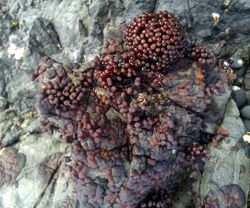Biology:Apophlaea
| Apophlaea | |
|---|---|

| |
| Apophlaea sinclairii by Peter de Lange | |
| Scientific classification | |
| (unranked): | Archaeplastida |
| Division: | Rhodophyta |
| Class: | Florideophyceae |
| Order: | Hildenbrandiales |
| Family: | Hildenbrandiaceae |
| Genus: | Apophlaea J.D.Hooker & Harvey, 1845 |
| Species | |
| |
Apophlaea is a genus of thalloid algae that is endemic to New Zealand.[1] This genus has two species, both from the high intertidal zone on New Zealand's coasts.[2][3] Specimens can reach around 15 cm in size. The thalli take a crustose form, but also contain upright, branching frond-like protrusions that reach 5–8 cm in height.[4][5] Secondary pit connections and secondary pit connectionsare present in the organisms. Apophlaea reproduces by means of conceptacles; it produces tetraspores.
It is notable for its symbiotic relationship with certain fungi.[6] Despite its unusual morphology, molecular systematics, along with its zoned tetrasporangia borne in conceptacles with a single opening, place it within the Hildenbrandiales.[7]
The algae are resistant to both U-V radiation and desiccation, allowing them to thrive in intertidal settings.[8] Indeed, they can resume almost full photosynthesis just minutes after losing 95% of their tissue water.[9]
References
- ↑ Nelson, Nelson, W. A. (2013). New Zealand seaweeds : an illustrated guide. Wellington, New Zealand: Te Papa Press. pp. 142. ISBN 9780987668813. OCLC 841897290. https://www.worldcat.org/oclc/841897290.
- ↑ Sherwood, A. R.; Sheath, R. G. (2003). "Systematics of the Hildenbrandiales (Rhodophyta): Gene Sequence and Morphometric Analyses of Global Collections". Journal of Phycology 39 (2): 409–422. doi:10.1046/j.1529-8817.2003.01050.x.
- ↑ Garbary, D. (2007). "The Margin of the Sea". ALGAE AND CYANOBACTERIA IN EXTREME ENVIRONMENTS. Cellular Origin, Life in Extreme Habitats and Astrobiology. 11. pp. 173–191. doi:10.1007/978-1-4020-6112-7_9.
- ↑ Saunders, G. W.; Bailey, J. C. (1999). "Molecular Systematic Analyses Indicate That the Enigmatic Apophlaea is a Member of the Hildenbrandiales (Rhodophyta, Florideophycidae)". Journal of Phycology 35: 171. doi:10.1046/j.1529-8817.1999.3510171.x.
- ↑ Sherwood, A. R.; Sheath, R. G. (2003). "Systematics of the Hildenbrandiales (Rhodophyta): Gene Sequence and Morphometric Analyses of Global Collections". Journal of Phycology 39 (2): 409–422. doi:10.1046/j.1529-8817.2003.01050.x.
- ↑ Selosse, M.; Le Tacon, F. (1998). "The land flora: a phototroph-fungus partnership?". Trends in Ecology & Evolution 13: 15–28. doi:10.1016/S0169-5347(97)01230-5.
- ↑ Saunders, G. W.; Bailey, J. C. (1999). "Molecular Systematic Analyses Indicate That the Enigmatic Apophlaea is a Member of the Hildenbrandiales (Rhodophyta, Florideophycidae)". Journal of Phycology 35: 171. doi:10.1046/j.1529-8817.1999.3510171.x.
- ↑ Garbary, D. (2007). "The Margin of the Sea". ALGAE AND CYANOBACTERIA IN EXTREME ENVIRONMENTS. Cellular Origin, Life in Extreme Habitats and Astrobiology. 11. pp. 173–191. doi:10.1007/978-1-4020-6112-7_9.
- ↑ Garbary, D. (2007). "The Margin of the Sea". ALGAE AND CYANOBACTERIA IN EXTREME ENVIRONMENTS. Cellular Origin, Life in Extreme Habitats and Astrobiology. 11. pp. 173–191. doi:10.1007/978-1-4020-6112-7_9.
External links
- Guiry, M.D.; Guiry, G.M. (2008). "Apophlaea". AlgaeBase. World-wide electronic publication, National University of Ireland, Galway. http://www.algaebase.org/search/genus/detail/?genus_id=42566. Retrieved 2009-04-19.
- http://thinkoholic.com/pic.php?l=de&resize=1&s=396&img=4194
- http://www.seafriends.org.nz/enviro/habitat/rsred.htm
Wikidata ☰ Q4780499 entry
 |

